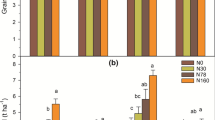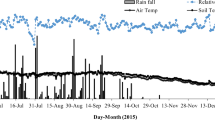Abstract
A pot experiment was conducted with rice to study the relative absorption of urea in molecular form compared to the other forms of N produced in soil from the applied urea. A method involving application of 14C-labelled urea and 15N-labelled urea alternately in two splits was used to quantify the absorption of molecular urea and other forms of N formed from it. Biomass production and N uptake were greater in plants grown under flooded soil conditions than in plants grown under non-flooded (upland) conditions. Absorption of N by rice increased with increasing rate of urea application up to 250 mg pot−1 and declined thereafter. The absorption of urea from the flooded soil constituted 9.4% of total N uptake from applied N compared to only 0.2% from the non-flooded. Under submerged conditions, absorption of urea from topdressing was about twice that from basal application at planting. High water solubility of the fertilizer and better developed rice root system might have enhanced the absorption of molecular urea by flooded rice, especially from topdressing. Thus, in the flooded rice system, the direct absorption of molecular urea from topdressing accounted for 6.3% of the total N uptake from added urea. Under upland condition, it was 0.12%.
Similar content being viewed by others
References
Beusichem M L van and Neeteson J J 1982 Urea nutrition of young maize and sugar beet plants with emphasis on ionic balance and vascular transport of nitrogenous compounds. Neth. J. Agric. Sci. 30, 317–330.
Bollard E G 1959 Urease and Ureides in plants. In Symposia of the Society for Experimental Biology, No.8, The University Press, Cambridge, UK, 304 pp.
Bradley D P, Morgan M A and O'Toole P 1989 Uptake and apparent utilization of urea and ammonium nitrate in wheat seedlings. Fertil. Res. 20, 41–49.
De Datta S K 1981 Chemical changes in submerged rice soils. In Principles and Practices of Rice Production. Ed. S K De Datta. pp 89–138. Wiley, New York.
Delaune R D and Patrick WH Jr 1970 Urea conversion to ammonia in waterlogged soils. Soil Sci. Soc. Am. Proc. 34, 603–607.
Farooqui MA R, Hanif M and DeMody C J 1983 Nitrogen mineralisation potential and urea hydrolysis under aerobic and anaerobic conditions. Commun. Soil Sci. Plant Anal. 14, 29–47.
IAEA (1976) Tracer Manual on Crops and Soils. Tech. Rep. Series, No. 171, International Atomic Energy Agency, Vienna, 277 pp.
Kielland K 1994 Amino acid absorption by arctic plants: implication for plant nitrigen and nitrogen cycling. Ecology 75, 2373–2383.
Kielland K 1995 Landscape patterns of free amino acids in arctic tundra soils. Biogeochemistry 31, 85–98.
Kielland K 1997 Role of free amino acids in the nitrogen economy of arctic cryptogram. Ecoscience 4, 75–79.
Mattingly G E G 1973 The Woburn organic experiment. II. Design, crop yields and nutrient balance, 1964–72. In Report for 1973, Part 2, (pmRothamsted Experimental Station, Harpdenden, UK), p 98–133.
Mitsui S and Kurihara K 1962 The intake and utilization of carbon by plant roots from 14C-labelled urea IV— Absorption of intact urea molecule and its metabolism in plant. Soil Sci. Plant Nutr. 8, 9–15.
Pulford I D and Tabatabai M A 1988 Effect of waterlogging on enzyme activities in soils. Soil Biol. Biochem. 20, 215–219.
Saraswathi P, Balachandran P V and Wahid P A 1991 Inhibition of urea hydrolysis in flooded soils and its significance in the molecular absorption of urea by rice. Soil Biol. Biochem. 23, 125–129.
Savant N K, James A F and McClellan G H 1985 Effect of soil submergence on urea hydrolysis. Soil Sci. 148, 81–86.
Skujins J J and McLaren A D 1969 Assay of urease activity using 14C-urea in stored, geologically preserved and irradiated soils. Soil Biol. Biochem. 1, 383–421.
Vlek P L G and Carter M F 1983 The effect of soil environment and fertilizer modification on the rate of urea hydrolysis. Soil Sci. 136, 56–63.
Vlek P L G, Stumple J M and Byrnes B H 1980 Urease activity and inhibition in flooded soil systems. Fertil. Res. 1, 191–202.
Yamagata M and Ae N 1996 Nitrogen uptake response of crops to organic nitrogen. Soil Sci. Plant Nutr. 42, 389–394.
Yangisawa M A, Irobe S, Lida M and Yamasaki K 1967 On the efficiency of nitrogen received by direct sowing paddy rice at different growth stages. J. Soil Sci. Manure 38, 37–42.
Author information
Authors and Affiliations
Rights and permissions
About this article
Cite this article
Safeena, A., Wahid, P., Balachandran, P. et al. Absorption of molecular urea by rice under flooded and non-flooded soil conditions. Plant and Soil 208, 161–166 (1999). https://doi.org/10.1023/A:1004439503573
Issue Date:
DOI: https://doi.org/10.1023/A:1004439503573




